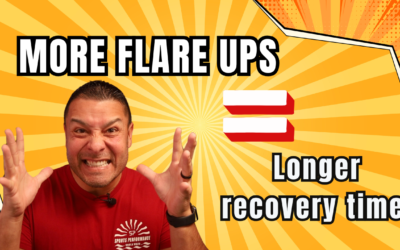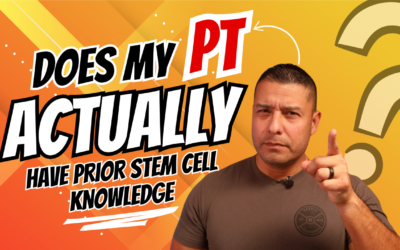“Your PT Might Worsen Your Recovery”
If you’ve recently undergone stem cell therapy, one of the biggest questions you may be asking is: “Should I recover through in-person physical therapy, virtual consultations, or a combination of both?” Each approach offers unique benefits, but choosing the right method based on your individual recovery needs is important. In this blog, we’ll explore the options and help you make an informed decision to optimize your healing process.
Understanding Stem Cell Recovery and Physical Therapy
After a stem cell procedure, your body undergoes a unique healing process that differs from traditional injuries or surgeries. While many people have had positive experiences with physical therapy in the past, stem cell recovery requires a different approach. Physical therapists are often generalists or may specialize in areas like the knee, back, or neck. However, stem cell recovery is a novel process, and there are currently no specific courses or standard protocols.
This means that your regular physical therapist, even if you’ve trusted them for years, may not have the expertise needed to guide you through this highly specialized recovery process. Stem cells respond differently depending on the individual, especially if you’ve undergone intravenous (IV) stem cell therapy or have underlying conditions like arthritis or multiple sclerosis. Physical therapists without stem cell experience may unknowingly push you too hard or hold you back when they shouldn’t, resulting in flare-ups or delayed progress.
Why Experience Matters in Stem Cell Recovery
Stem cell recovery is a long-term commitment, often spanning six months to a year. During this time, you may experience ups and downs—some days you’ll feel great, while other days may bring unexpected setbacks. This is entirely normal. The key is working with someone who understands these fluctuations and can help you navigate them safely.
A physical therapist who lacks experience with stem cells may misinterpret your progress. For instance, they might believe you’re ready to push harder because you’re feeling good, only to trigger a flare-up that sets you back. Or, they may stop your therapy prematurely because they don’t realize that some discomfort is part of the natural healing process. Understanding the risks and being able to identify “yellow flags” during recovery is crucial for long-term success.
Your Three Recovery Options
So, what are your options? Broadly speaking, you have three routes to consider:
1. In-Person Physical Therapy
If you have access to a local physical therapist with experience in stem cell recovery, this can be a great option. Hands-on treatment, such as stretching and manual therapy, can be beneficial—if the therapist knows the intricacies of stem cell healing. However, if your therapist has little or no experience with this type of recovery, you might find yourself becoming a “guinea pig.” Be sure to ask how many stem cell patients they’ve worked with before committing to this option.
2. Virtual Consultation
For many, finding a local expert in stem cell recovery isn’t feasible. In this case, virtual consultations with specialists can provide a detailed roadmap for your recovery. A virtual consultant will guide you step-by-step, letting you know what to expect at each phase of the process—from month one through month six or beyond. They’ll provide advice on when to push harder and when to pull back, helping you avoid common mistakes that could slow your progress or worsen your condition.
3. Hybrid Approach
One of the most effective recovery strategies is a hybrid approach, combining in-person physical therapy with virtual consulting. This allows you to work with a trusted local therapist for hands-on care while also receiving expert guidance from a specialist. Together, they can collaborate on your treatment plan, ensuring you progress at the right pace. The virtual consultant will provide the bigger picture, while the local therapist can make real-time adjustments based on your daily condition.
Why Less is More in Stem Cell Recovery
One of the most critical aspects of stem cell recovery is the principle that “less is more.” It’s tempting to want to push yourself, especially if you’re used to being active. However, stem cells are highly sensitive to stress, and pushing too hard can lead to setbacks. Recovery should be slow and steady, even if you’re feeling good. This requires a mental shift from the traditional “no pain, no gain” mindset to a more cautious, long-term approach.
Your recovery plan should include clearly defined milestones, such as when to start running, lifting weights, or increasing activity levels. These milestones aren’t just about how you feel on a given day; they’re based on how your body is responding to the therapy over time. A virtual consultant can help create this roadmap for you, giving you peace of mind and ensuring you’re on the right path.
Making the Best Choice for Your Recovery
So, how do you decide which approach is right for you? It ultimately depends on your location, access to specialists, and personal preferences. If you trust your local physical therapist but lack stem cell experience, consider supplementing their care with virtual consulting. This hybrid approach gives you the best of both worlds—hands-on care from someone you trust and expert guidance from someone who knows exactly what to expect during the recovery process.
Remember, the goal of stem cell recovery is not just to feel better in the short term but to maximize your long-term outcomes. By carefully weighing your options and choosing the right path, you can reduce the risk of setbacks and flare-ups, ensuring a smoother, more successful recovery.
Final Thoughts
Recovering from stem cell therapy is a unique process that requires a different approach from traditional physical therapy. Whether you choose in-person treatment, virtual consulting, or a hybrid of both, it’s essential to work with healthcare professionals who understand the specific challenges and milestones of stem cell recovery. By making an informed decision, you can maximize your results and get back to living your best life.
For more resources or assistance with your recovery, feel free to reach out to the Stem Cell Recovery Experts who specialize in stem cell rehabilitation. For more recovery tips and long-lasting results, feel free to give us a call (619-397-1391). We’re here to help!
If you found these tips helpful, don’t forget to subscribe to our YouTube channel (CLICK HERE) for weekly updates on how to recover safely and effectively after stem cell therapy.
If you’re a visual learner, check out the YouTube video I created on this topic:
If you have any questions, please email us at recovery@sportsperformancept.com.
Sincerely,
Dr. Chris Garcia, PT, DPT, SCS, CSCS, USAW

“Dr. Chris Garcia is the world-renowned expert on stem cell recovery, internationally recognized public speaker, and trusted advisor to physical therapists globally.”
How to Approach Rehab After a Second Round of Stem Cell Injections
"How to Approach Rehab After a Second Round of Stem Cell Injections"Are you gearing up for your second round of stem cell injections and wondering how to adjust your rehab plan? Does it differ from the first set of injections? Let’s dive into what changes, what...
How More Flare-Ups Increase Recovery Time and Keep You Inactive
"How More Flare-Ups Increase Recovery Time and Keep You Inactive"Flare-ups after stem cell injections can significantly delay your recovery, sometimes doubling the time it takes to heal. Understanding the reasons behind these setbacks and how to avoid them can make...
Should My Physical Therapist Have Prior Stem Cell Experience?
"Should My Physical Therapist Have Prior Stem Cell Experience?"Are you approaching six months post-stem cell injections and wondering what’s next? Many people are uncertain about whether they need to continue any specific recovery steps. Let’s break down what you...
Subscribe
Get notified with new blog posts to heal after stem cell therapy



